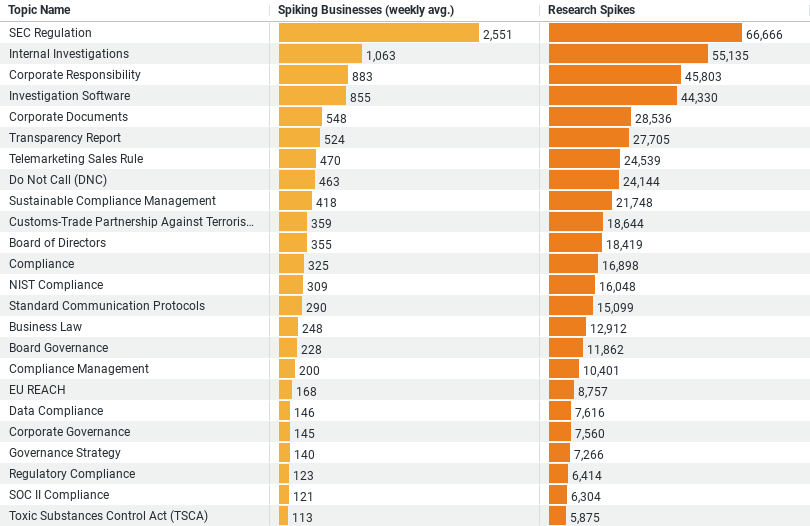Executive Summary: Compliance & Governance Research Trends in the Construction Industry
– SEC Regulation emerges as the most significant concern, evidenced by the highest weekly average of researching businesses (2,550.54) and the total number of research spikes (66,666).
– Internal Investigations show substantial interest, with a weekly average of 1,062.88 businesses researching this topic and a total of 55,135 research spikes, indicating a proactive approach towards compliance and governance internally.
– Corporate Responsibility reflects growing industry commitment to ethical practices, with 883.13 businesses researching it weekly and 45,803 total research spikes.
– Investigation Software highlights the industry’s turn towards digital solutions for compliance and governance, with 854.67 weekly researching businesses and 44,330 research spikes.
– Corporate Documents point to the importance of document management for compliance, with a weekly average of 548.02 businesses researching and a total of 28,536 research spikes.
This summary encapsulates the construction industry’s focus areas within Compliance & Governance, illustrating a strategic emphasis on regulatory adherence, ethical business practices, and technological integration for enhanced governance.
The Paramount Concern: SEC Regulation
At the forefront of the industry’s collective mind is SEC Regulation, a topic that has garnered the most attention, with an average of 2,550.54 businesses researching it weekly, accompanied by a staggering 66,666 research spikes. This intense focus underscores the industry’s acute awareness of the importance of adhering to the Securities and Exchange Commission’s guidelines. The reasons behind this concentrated interest could range from the direct impact of these regulations on project financing and public offerings to the broader implications for corporate transparency and investor relations. The data speaks volumes about the construction sector’s endeavor to not only comply with existing regulations but also to anticipate and adapt to emerging regulatory landscapes.
Internal Affairs: The Emphasis on Internal Investigations
Closely following the interest in SEC regulations is the industry’s investment in Internal Investigations, with 1,062.88 businesses researching this topic weekly and a total of 55,135 research spikes. This trend signals a proactive stance towards identifying and mitigating potential compliance issues before they escalate. Internal investigations play a critical role in this process, serving as a mechanism for companies to ensure that their operations, employees, and business practices adhere to legal and ethical standards. This area of focus reflects a broader commitment to fostering a culture of integrity and accountability within the construction sector.
A Commitment to Corporate Responsibility
The data also highlights a significant interest in Corporate Responsibility, with 883.13 businesses per week delving into this subject, culminating in 45,803 research spikes. This trend illustrates the construction industry’s growing recognition of its social, environmental, and economic impact. From sustainable building practices to ethical labor relations and community engagement, corporate responsibility encompasses a wide array of practices aimed at doing business in a way that is ethical, transparent, and beneficial to society at large. The industry’s research efforts in this area are indicative of a shift towards more responsible and sustainable business models.
Technological Solutions: Investigation Software
With 854.67 businesses researching Investigation Software weekly and a total of 44,330 research spikes, there’s a clear indication of the sector’s reliance on technology to enhance its compliance and governance frameworks. Investigation software can streamline the process of conducting internal investigations, managing documents, and ensuring regulatory compliance. This focus on technology solutions signifies the industry’s pursuit of efficiency, accuracy, and accountability in its governance practices, leveraging digital tools to support these objectives.
The Bedrock of Governance: Corporate Documents
Lastly, the interest in Corporate Documents, researched weekly by 548.02 businesses with 28,536 research spikes, underscores the foundational role of documentation in compliance and governance. Effective management of corporate documents — from contracts and agreements to compliance records and policies — is critical for meeting regulatory requirements, supporting internal audits, and facilitating transparent business practices. This area of focus reflects the construction industry’s commitment to maintaining rigorous standards of documentation and record-keeping.
Conclusion
The construction industry’s research interests in Compliance & Governance reveal a sector that is actively engaging with the complex regulatory environment in which it operates. From a keen focus on SEC regulations to the embrace of technology in governance practices, these trends demonstrate the industry’s commitment to upholding high standards of compliance, ethical conduct, and corporate responsibility. As the sector continues to evolve, these insights provide a valuable snapshot of the priorities and strategies that are guiding its journey towards a more compliant, responsible, and sustainable future.
Company Sample Data and Trend Analysis
Understanding the Data
The dataset categorizes companies into five sizes:
1. Micro (1 – 9 Employees)
2. Small (10 – 49 Employees)
3. Medium-Small (50 – 199 Employees)
4. Medium (200 – 499 Employees)
5. Medium-Large (500 – 999 Employees)
For each category, two metrics are provided: the average weekly number of spiking businesses (indicating how many companies show a peak in research activity on Compliance & Governance topics) and their percent of the total research activity observed.
Trend Insights
– Micro-sized companies, while smallest in operational scale, demonstrate a notable engagement in compliance and governance research, with an average of 596.21 businesses showing interest weekly. This represents about 9.67% of total research activity, highlighting that even the smallest businesses are acutely aware of the importance of compliance, possibly due to their vulnerability to regulatory missteps.
– Small-sized companies exhibit a significantly higher level of activity, with 1,580.1 businesses spiking weekly, accounting for 25.63% of total research. This suggests a growing awareness and need for compliance strategies as businesses expand and face more complex regulatory environments.
– Medium-Small sized companies show the highest level of engagement, with 1,785.94 businesses spiking weekly, making up 28.96% of total research. This peak in activity could reflect the critical point at which companies have sufficient resources to dedicate to compliance issues and face increasing regulatory scrutiny due to their size and impact.
– Medium-sized companies, with 914.02 spiking businesses weekly (14.82% of total research), show a decrease in relative research activity compared to medium-small companies. This might indicate a plateau in compliance and governance challenges or a better integration of compliance systems that require less frequent research as companies grow.
– Medium-Large sized companies have 483.38 spiking businesses weekly, representing 7.84% of the total. This further decrease could suggest that larger companies have established compliance departments or practices, reducing the need for external research.
Why This Trend?
The trend across various company sizes indicates a bell curve in compliance and governance research intensity, peaking with medium-small companies. This pattern likely reflects the evolving challenges and resources available to companies as they grow. Smaller companies, with limited resources, might prioritize immediate compliance issues out of necessity. As companies grow, they encounter more complex regulatory landscapes, increasing the demand for compliance research. However, beyond a certain size threshold, companies likely develop internal capabilities to manage compliance, decreasing the dependency on external research.
This trend underscores the importance of scalability in compliance and governance strategies. As companies grow, their approach to compliance must evolve, moving from reactive to proactive and eventually integrating comprehensive internal systems capable of handling the complexities of their regulatory environment.
In conclusion, the data reveals not just how companies of different sizes engage with compliance and governance issues, but also hints at the lifecycle of compliance maturity as companies evolve. Understanding this dynamic is crucial for businesses aiming to navigate the intricacies of regulatory compliance efficiently and effectively, regardless of their size.



